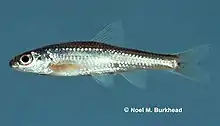Bigeye chub
Bigeye chub (Hybopsis amblops) is a species of freshwater fish in the carp family (Cyprinidae).
| Bigeye chub | |
|---|---|
 | |
| Scientific classification | |
| Kingdom: | Animalia |
| Phylum: | Chordata |
| Class: | Actinopterygii |
| Order: | Cypriniformes |
| Family: | Leuciscidae |
| Subfamily: | Pogonichthyinae |
| Genus: | Hybopsis |
| Species: | H. amblops |
| Binomial name | |
| Hybopsis amblops (Rafinesque, 1820) | |
| Synonyms | |
| |
Geographic distribution
The native range of the Bigeye chub includes the Lake Ontario and Lake Erie drainages in New York, Pennsylvania, Ohio, and Michigan as well as the Ohio River basin from New York to eastern Illinois and south to the Tennessee River drainage, Georgia and Alabama, and the Ozarks of southern Missouri, northern Arkansas, and northeastern Oklahoma. There is one record of this species in the Cottonwood River in Kansas. It is absent from the Missouri River drainage. This species in endangered in Illinois. [1]
Ecology
The Bigeye chub is a freshwater fish of the United States. It prefers a habitat near riffles in quiet water with aquatic vegetation, in small to moderate size, clear-water tributaries with a sand, gravel, or rocky substrate. It is highly intolerant of siltation.[1]
Characteristics
This species has a long, blunt snout with a down turned, overhanging mouth. It is a light greenish yellow color, besides the black lateral stripe stretching from its mouth to the tail. Like other Hybopisis, this genus has a single mouth barbel that contains taste buds. The bigeye chub has an elliptical eye shape that is directed upward. They reach about 2 to 3 inches in length. Their diet consists of aquatic insects such as different kinds of larvae and large mayfly.
History
The Bigeye chub experienced drastic population declines in the mid 20th century. In the 1970's and 1980's, they were so rapidly disappearing they were thought to be extirpated. With recovery methods and research, a steady increase has been seen since 2000 in central Illinois. However, they are still considered endangered.
References
- NatureServe (2013). "Hybopsis amblops". The IUCN Red List of Threatened Species. IUCN. 2013: e.T202116A18232700. doi:10.2305/IUCN.UK.2013-1.RLTS.T202116A18232700.en.

